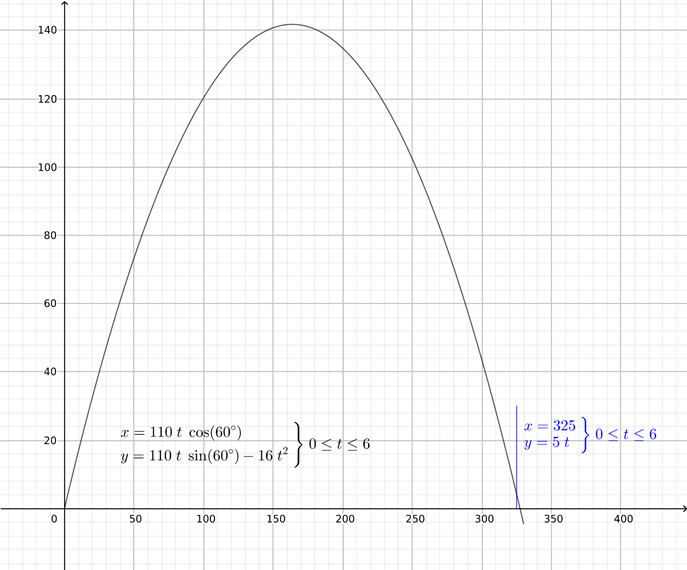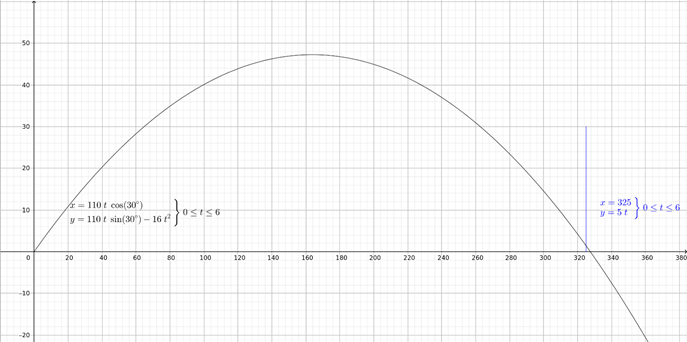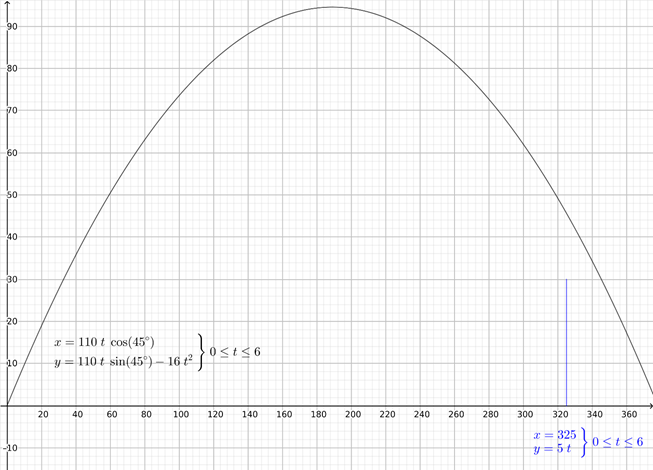
a.
To Graph: The parametric equations which represent the position of a fly ball and the fence at the boundary respectively for
To State: Whether the fly ball clears the fence.
The fly ball does not clear the fence.
Given: The parametric equations which represent the position of a fly ball and the fence at the boundary respectively:
The allowed values
Concepts Used:
The function call
The function call
For the fly ball to clear the fence, the graph of trajectory of ball must pass above the fence without touching it.
Graph:

Interpretation:
The trajectory of the fly ball has not passed completely above the fence. It hits the fence near its bottom. So, the fly ball does not clear the fence.
b.
To Graph: The parametric equations given in the previous part for the angle
To State: Whether the fly ball clears the fence.
The fly ball does not clear the fence.
Given: The parametric equations which represent the position of a fly ball and the fence at the boundary respectively:
The allowed values
Concepts Used:
The function call
The function call
For the fly ball to clear the fence, the graph of trajectory of ball must pass above the fence without touching it.
Graph:

Interpretation:
The trajectory of the fly ball has not passed completely above the fence. It hits the fence near its bottom. So, the fly ball does not clear the fence.
c.
To Determine: The optimal angle for hitting the ball.
To State: Whether the fly ball clears the fence.
The optimal angle is
Given: The parametric equations which represent the position of a fly ball and the fence at the boundary respectively:
The allowed values
Concepts Used:
The function call
The function call
For the fly ball to clear the fence, the graph of trajectory of ball must pass above the fence without touching it.
Graph:
By the process of hit and trial to plot the trajectory of the ball for various angles of hitting the ball, it was found that maximum distance was covered when the angle of hitting was

Interpretation:
The optimal angle is
Chapter 1 Solutions
PRECALCULUS:...COMMON CORE ED.-W/ACCESS
- mate hat is the largest area that can be en 18 For the function y=x³-3x² - 1, use derivatives to: (a) determine the intervals of increase and decrease. (b) determine the local (relative) maxima and minima. (c) determine the intervals of concavity. (d) determine the points of inflection. b) (e) sketch the graph with the above information indicated on the graph.arrow_forwarduse L'Hopital Rule to evaluate the following. a) 4x3 +10x2 23009׳-9 943-9 b) hm 3-84 хто бу+2 < xan x-30650)arrow_forwardEvaluate the next integralarrow_forward
- 1. For each of the following, find the critical numbers of f, the intervals on which f is increasing or decreasing, and the relative maximum and minimum values of f. (a) f(x) = x² - 2x²+3 (b) f(x) = (x+1)5-5x-2 (c) f(x) = x2 x-9 2. For each of the following, find the intervals on which f is concave upward or downward and the inflection points of f. (a) f(x) = x - 2x²+3 (b) g(x) = x³- x (c) f(x)=x-6x3 + x-8 3. Find the relative maximum and minimum values of the following functions by using the Second Derivative Test. (a) f(x)=1+3x² - 2x3 (b) g(x) = 2x3 + 3x² - 12x-4arrow_forwardFind the Soultion to the following dy differential equation using Fourier in transforms: = , хуо, ухо according to the terms: lim u(x,y) = 0 x18 lim 4x (x,y) = 0 x14 2 u (x, 0) = =\u(o,y) = -y لوarrow_forwardCan you solve question 3,4,5 and 6 for this questionarrow_forward
- water at a rate of 2 m³/min. of the water height in this tank? 16) A box with a square base and an open top must have a volume of 256 cubic inches. Find the dimensions of the box that will minimize the amount of material used (the surface area). 17) A farmer wishes toarrow_forward#14 Sand pours from a chute and forms a conical pile whose height is always equal to its base diameter. The height o the pile increases at a rate of 5 feet/hour. Find the rate of change of the volume of the sand in the conical pile when the height of the pile is 4 feet.arrow_forward(d)(65in(x)-5 cos(x) dx mins by 5x-2x² 3x+1 dx -dx 20 Evaluate each the following indefinite integralsarrow_forward
- 19 Evaluate each the following definite integrals: a) લ b) (+3) 6) (2-2)(+33) dxarrow_forward#11 If a snowball melts so its surface area decreases at a rate of 1cm²/min, find the rate at which the diameter decreases when the diameter is 6 cm.arrow_forwardUse Deritivitve of the inverse to solve thisarrow_forward
 Calculus: Early TranscendentalsCalculusISBN:9781285741550Author:James StewartPublisher:Cengage Learning
Calculus: Early TranscendentalsCalculusISBN:9781285741550Author:James StewartPublisher:Cengage Learning Thomas' Calculus (14th Edition)CalculusISBN:9780134438986Author:Joel R. Hass, Christopher E. Heil, Maurice D. WeirPublisher:PEARSON
Thomas' Calculus (14th Edition)CalculusISBN:9780134438986Author:Joel R. Hass, Christopher E. Heil, Maurice D. WeirPublisher:PEARSON Calculus: Early Transcendentals (3rd Edition)CalculusISBN:9780134763644Author:William L. Briggs, Lyle Cochran, Bernard Gillett, Eric SchulzPublisher:PEARSON
Calculus: Early Transcendentals (3rd Edition)CalculusISBN:9780134763644Author:William L. Briggs, Lyle Cochran, Bernard Gillett, Eric SchulzPublisher:PEARSON Calculus: Early TranscendentalsCalculusISBN:9781319050740Author:Jon Rogawski, Colin Adams, Robert FranzosaPublisher:W. H. Freeman
Calculus: Early TranscendentalsCalculusISBN:9781319050740Author:Jon Rogawski, Colin Adams, Robert FranzosaPublisher:W. H. Freeman
 Calculus: Early Transcendental FunctionsCalculusISBN:9781337552516Author:Ron Larson, Bruce H. EdwardsPublisher:Cengage Learning
Calculus: Early Transcendental FunctionsCalculusISBN:9781337552516Author:Ron Larson, Bruce H. EdwardsPublisher:Cengage Learning





